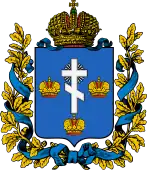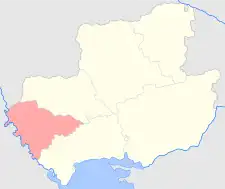Tiraspol uezd
The Tiraspol uezd[lower-alpha 1] was a county (uezd) of the Kherson Governorate of the Russian Empire. The uezd bordered the Balta uezd of the Podolia Governorate to the north, the Ananev uezd to the east, the Odessa uezd to the south, and the Akkerman and Bendery uezd of the Bessarabia Governorate to the west. The administrative centre of the county was Tiraspol. The area of the Tiraspol uezd corresponded to most of Odesa Oblast and the breakaway territory of Transnistria, which is a part of Moldova.
Tiraspol uezd
Тираспольскій уѣздъ | |
|---|---|
 Coat of arms | |
 Location in the Kherson Governorate | |
| Country | Russian Empire |
| Governorate | Kherson |
| Established | 1803 |
| Abolished | 1923 |
| Capital | Tiraspol |
| Area | |
| • Total | 7,228.97 km2 (2,791.12 sq mi) |
| Population (1897) | |
| • Total | 206,568 |
| • Density | 29/km2 (74/sq mi) |
| • Urban | 21.37% |
| • Rural | 78.63% |
Administrative divisions
The subcounties (volosts) of the Tiraspol uezd in 1912 were as follows:[1]
| Name | Name in Russian | Capital |
|---|---|---|
| Glikstal volost | Гликстальская волость | Glikstal |
| Gofnungstal volost | Гофнунгстальская волость | Tsebrikova |
| Demidovka volost | Демидовская волость | Demidovka |
| Dubovoe volost | Дубовская волость | Dubovoe |
| Evgenievka volost | Евгеніевская волость | Evgenievka |
| Zakharevka volost | Захарьевская волость | Zakharevka |
| Kassel volost | Кассельская волость | Kassel |
| Katarzhina volost | Катаржинская волость | Katarzhina |
| Korotkoe volost | Коротнянская волость | Korotkoe |
| Lunga volost | Лунговская волость | Lunga |
| Malaeshty 1-oe volost | Малаештская 1-ая волость | Malaeshty 1-oe |
| Malaeshty 2-oe volost | Малаештская 2-ая волость | Malaeshty 2-oe |
| Maligonova volost | Малигоновская волость | Maligonova |
| Novo-Petrovka volost | Ново-Петровская волость | Mikhailovka |
| Parkany volost | Парканская волость | Parkany |
| Petroverovka volost | Петровѣровская волость | Petroverovka |
| Ploskaya volost | Плосковская волость | Ploskaya |
| Ponyatovka volost | Понятовская волость | Ponyatovka |
| Rossiyanka volost | Россіяновская волость | Rossiyanka |
| Slobodzeya volost | Слободзейская волость | Slobodzeya |
| Tashlyk volost | Ташлыкская волость | Tashlyk |
Demographics
At the time of the Russian Empire Census on 28 January [O.S. 15 January] 1897, the Tiraspol uezd had a population of 240,145, including 123,218 men and 116,927 women. The majority of the population indicated Little Russian[lower-alpha 2] to be their mother tongue, with significant Romanian, Great Russian, Jewish, and German speaking minorities.[4]
| Language | Native speakers | Percentage |
|---|---|---|
| Ukrainian language | 80,049 | 33.33 |
| Romanian | 59,794 | 24.90 |
| Great Russian[lower-alpha 2] | 40,703 | 16.95 |
| Jewish | 23,811 | 9.92 |
| German | 23,527 | 9.80 |
| Bulgarian | 8,801 | 3.66 |
| Polish | 1,907 | 0.79 |
| Armenian | 475 | 0.20 |
| White Russian[lower-alpha 2] | 352 | 0.15 |
| Gipsy | 261 | 0.11 |
| Tatar | 138 | 0.06 |
| Greek | 106 | 0.04 |
| Czech | 76 | 0.03 |
| Mordovian | 34 | 0.01 |
| Italian | 18 | 0.01 |
| Latvian | 15 | 0.01 |
| French | 13 | 0.01 |
| South Slavic | 11 | 0.00 |
| Lithuanian | 10 | 0.00 |
| Estonian | 9 | 0.00 |
| Georgian | 3 | 0.00 |
| Turkish | 3 | 0.00 |
| Swedish | 2 | 0.00 |
| English | 1 | 0.00 |
| Others | 66 | 0.03 |
| Total | 240,145 | 100.00 |
Notes
-
- Russian: Тира́спольскій уѣ́здъ, romanized: Tiráspolʼskiy uyézd
- Ukrainian: Тира́спольський пові́т, romanized: Tyráspolʼsʼkyi povít
- Moldovan Cyrillic: Цинутул Тираспол, romanized: Ținutul Tiraspol
- Prior to 1918, the Imperial Russian government classified Russians as the Great Russians, Ukrainians as the Little Russians, and Belarusians as the White Russians. After the creation of the Ukrainian People's Republic in 1918, the Little Russians identified themselves as "Ukrainian".[2] Also, the Belarusian Democratic Republic which the White Russians identified themselves as "Belarusian".[3]
References
- Волостныя, станичныя, сельския, гминныя правления и управления, а также полицейские станы всей России с обозначением места их нахождения [Volostny, stanichnaya, rural, communes of government and administration, as well as police camps throughout Russia with the designation of their location]. Kiev: Izd-vo T-va L. M. Fish. 1913. p. 191. Archived from the original on 2022-12-11.
- Hamm, Michael F. (2014). Kiev: A Portrait, 1800–1917. Princeton University Press. p. 83. ISBN 978-1-4008-5151-5.
- Fortson IV, Benjamin W. (2011). Indo-European Language and Culture: An Introduction. John Wiley & Sons. p. 429. ISBN 978-1-4443-5968-8.
- "Демоскоп Weekly - Приложение. Справочник статистических показателей". www.demoscope.ru. Retrieved 2019-12-20.